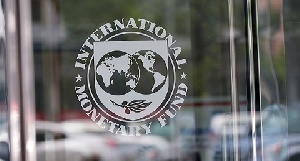 International Monetary Fund (IMF)
International Monetary Fund (IMF)
After government spent some GH¢12billion in cleaning up the banking sector, the International Monetary Fund (IMF) estimates a third of that amount is needed to secure depositors’ funds lodged with various Micro-Finance Institutions (MFIs) and Saving and Loans (S&L) companies.
The Fund estimates that intervention in the S&L and other finances houses alone will cost the taxpayer GH¢3billion, while for the MFIs it will cost GH¢1billion.
This means the total amount to be spent on securing deposits in the banking and allied financial intuitions sectors will be approximately GH¢16billion, which is equal to half of the country’s annual tax revenue.
The IMF says it is imperative government looks for funds to complete what it calls ‘the financial sector reform strategy’. “During 2018, the BoG conducted an analysis of microfinance institutions (MFI) and rural banks in cooperation with the World Bank, identifying a large number of institutions which warrant prompt intervention to protect depositors and enable the sector contribute to financial sector development and inclusion.
“A clean-up of the savings and loans companies and finance houses also showing signs of distress will complete the financial sector reform strategy. The BoG is finalising plans to intervene with distressed institutions; the sector’s clean-up will require mobilisation of government funding to cover resolution costs (as a first step, funding for MFIs is being secured),” the IMF report stated.
Though the amount needed to undertake the second phase of the financial sector reforms is now clear, what remains unknown is the method Bank of Ghana will adopt to carry out the exercise.
A similar exercise in the universal banking space saw the creation of Consolidated Bank Ghana, and the deposits of customers with five banks transferred to the new entity. Hundreds of people lost their jobs when the five banks went under, and confidence in the banking sector was initially shattered.
When the central bank governor, Dr. Ernest Addison, was queried by B&FT at the announcement of the policy rate earlier this month on the modality the exercise will take, he remained tight-lipped on the subject, saying: “The modalities will become clearer when the time approaches”.
Despite his reluctance to comment on the approach, Dr. Addison hinted last year September that in the worst-case scenario, insolvent non-bank financial institutions will be liquidated as happened to the five banks last year.
“We are discussing with the Ministry of Finance the measures which need to be taken to stabilise that segment of the market. Measures for stabilising the savings and loans segment of the financial market are no different from the measures which have been taken with regard to the banks. If these savings and loans companies are insolvent, they will have to be liquidated; that is the solution for insolvent financial institutions,” he said.
The deposits of these institutions, he said, are not insured – for which reason there has to be a cost associated to dealing with them, with implications on the budget.